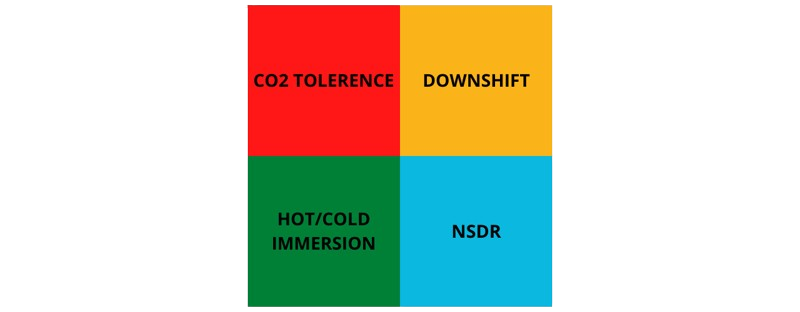PEAK PERFORMANCE: THE POWER TO PERFORM
It's the key that unlocks your body's full potential. When you learn to harness the breath, you gain control over your physiology and your psychology. It's not just about oxygenating your cells, although that's crucial. It's about tapping into a source of unlimited energy and focus. When you master your breath, you can instantly shift your state, from stressed to serene, from tired to energised. It's the gateway to unlocking your peak performance, enabling you to achieve your goals with unparalleled vitality and clarity.

CO2 TOLERENCE
CO2 tolerance work in breathwork refers to specific techniques and exercises designed to increase an individual's tolerance to elevated levels of carbon dioxide (CO2) in their bloodstream. It is a type of breathwork practice that aims to improve a person's ability to withstand and effectively manage higher CO2 concentrations, often by intentionally inducing a state of hypercapnia (elevated CO2 levels).
Here's how CO2 tolerance work typically functions:
- Elevated CO2 Levels: CO2 is a natural byproduct of cellular metabolism, and its levels in the body are tightly regulated. However, when you deliberately increase your respiratory rate or practice breath-holding techniques, you retain more CO2 than you would during normal breathing. This leads to a temporary elevation in blood CO2 levels.
- Response Adaptation: The body responds to elevated CO2 levels with various physiological reactions. Initially, you may experience a strong urge to breathe or discomfort. However, with consistent practice, your body can adapt to these higher CO2 levels, and the discomfort diminishes over time.
- Enhanced Tolerance: Through regular CO2 tolerance work, individuals can gradually increase their ability to tolerate higher CO2 concentrations without experiencing significant discomfort or the need to take rapid breaths. This increased tolerance can have various benefits, including improved breath control, reduced anxiety related to breathlessness, and enhanced endurance in activities that require controlled breathing, such as certain sports and breath-hold diving.
DOWNSHIFT
Downshifting in breathwork refers to the intentional slowing down and relaxation of the breath and the nervous system. It involves transitioning from a state of heightened alertness or rapid breathing to a more calm and controlled breathing pattern. Downshifting is a valuable technique to induce relaxation, reduce stress, and activate the parasympathetic nervous system's "rest and digest" response. This can lead to a sense of calm, improved mental clarity, and reduced physiological arousal.
HOT/COLD IMMERSION:
The intention of applying breathwork to hot/cold immersions, such as cold water baths or hot saunas, is to enhance the body's response to these extreme temperature changes. Breathwork can be used to optimise the body's adaptation to stressors like cold exposure (cold stress) and heat exposure (heat stress).
In cold immersion, specific breathwork techniques can help improve cold tolerance and reduce the shock of cold water on the body. Controlled breathing can minimise the body's stress response, increase circulation, and promote warmth. In contrast, during hot immersion, breathwork can aid in maintaining calm and regulating body temperature.
The combination of breathwork with hot/cold immersion experiences is often used in practices like the Wim Hof Method. It can offer benefits such as increased resilience to temperature extremes, improved mental focus, enhanced circulation, and a sense of invigoration or relaxation, depending on the context. The intention is to harness the power of breath to optimise the body's response to these environmental stressors.
NSDR(NON SLEEP DEEP REST):
Non-Sleep Deep Rest (NSDR) is a state of profound relaxation and restorative rest that can be achieved without actual sleep. It involves a deep level of relaxation that allows the body to recover and rejuvenate, similar to the benefits of sleep, but without entering a full sleep cycle.
During NSDR, the body's physiological functions slow down, and the mind enters a tranquil and meditative state. This state is often associated with practices like meditation, yoga nidra, or specific breathwork techniques designed to induce relaxation. NSDR can provide various benefits, including reduced stress, improved mental clarity, and enhanced overall well-being. It can be a valuable tool for relaxation and stress management, especially for those who have difficulty achieving restful sleep.
TECHNIQUES:
1. CO2 TOLERENCE + DOWNSHIFT:
A. PROGRESSIVE BOX BREATH: Start off with a 2 count on your first round, adding on an extra count on each round after that all the way up to a count of 10
B. DOWNSHIFT:
- 3 X Nasal inhale followed by a Physiological sigh exhale out the mouth
- 5 X Nasal inhale followed by elongated exhale out
- 5 X Nasal only inhale & exhales to a 1:1 ratio
2. HOT / COLD IMMERSION:
- 10 X Nasal inhale followed by elongated exhale out
- 5 X Nasal only inhale & exhales to a 1:1 ratio
TASK:
This week your task is to implement Performance Breathing into your Daily Rituals, EVERYDAY THIS WEEK! There are guided breathworks attached to this module for your convenience with your daily practice.
ENJOY!
